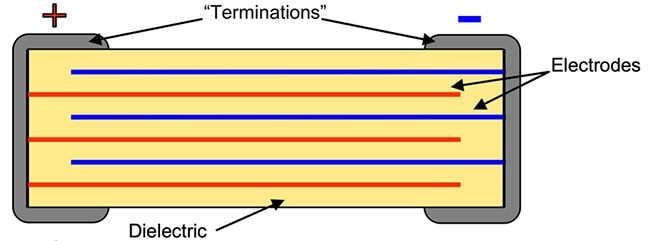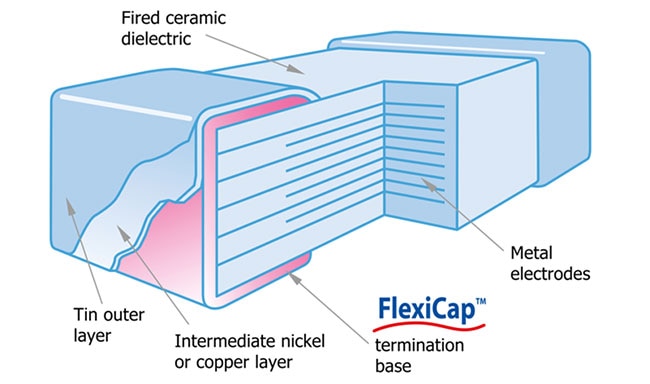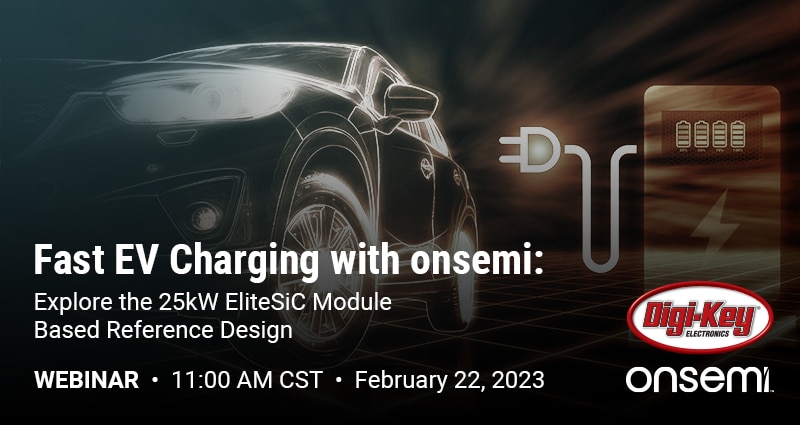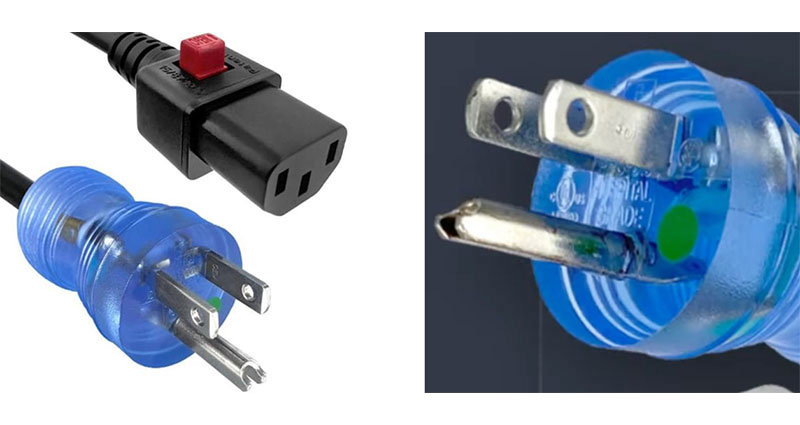For EVs, 800 Volt Multilayer Ceramic Capacitors With Flexible Terminations Ensure Safe, Reliable Charging
While the amount of electronics in vehicles is increasing rapidly, the industry focus has tended to be on sensors, engine control units (ECUs), navigation, in-cabin connectivity, audio, and, of course, advanced driver assistance systems (ADAS). As electric vehicles (EVs) go mainstream, high-voltage, high-reliability electronic components that can tolerate upwards of 800 volts while also meeting stringent environmental requirements have become critical. This need applies right down to the capacitor level, where standards such as AEC-Q200 must be met.
Fortunately, component manufacturers are well aware of the requirements. For example, the Knowles Syfer safety-certified surface-mount multilayer ceramic capacitor (MLCC) product line offers capacitors that comply with multiple international safety specifications and certifications—including AEC-Q200. They have also introduced components that have lower profiles and take less board space, critical features for space-constrained applications. In addition, the capacitors’ FlexiCap termination reduces their risk of mechanical cracking when they are on boards subject to vibration and shock, making them well-suited to EV applications. Let’s take a closer look at MLCC technology in order to understand its advantages.
The structure of MLCCs
MLCCs are surface-mount capacitors that are structured with a number of individual capacitor elements stacked vertically and connected in parallel by the end terminations (Figure 1).
 Figure 1: A cross-sectional view of the structure of an MLCC showing multiple capacitors stacked in a common package. (Image source: Knowles Syfer)
Figure 1: A cross-sectional view of the structure of an MLCC showing multiple capacitors stacked in a common package. (Image source: Knowles Syfer)
The parallel connection of multiple electrode + and - pairs permits the manufacture of large values of capacitance in a relatively small package.
The electrodes are metallic and highly conductive. The manufacturing process requires the electrodes to be unreactive chemically and have a high melting point. For this, the Knowles Syfer MLCC capacitors use a combination of silver and palladium as electrodes.
Dielectrics must also be good insulators. The relative permittivity (er) of the dielectric determines the attainable capacitance for a given component geometry. Knowles Syfer MLCCs offer two classes of ceramic dielectrics. The first is C0G/NP0, an EIA Class 1 dielectric, which has a relative permittivity of between 20 and 100, relative to the permittivity of a vacuum which has an er of 0. The second is X7R, an EIA Class 2 dielectric, with an er of between 2000 and 3000. The selection of the dielectrics affects the stability of the capacitor with respect to temperature, applied voltage, and time. In general, the higher the er, the less stable the capacitance value.
The EIA classifies Class 2 dielectrics with an alphanumeric classification. The first letter designates the minimum temperature, the number indicates the maximum temperature, and the final letter describes the capacitance tolerance. The X7R dielectric decodes into having a minimum temperature of -55°C, a maximum temperature of +125°C, and a capacitance tolerance of ±15%. Class 1 dielectrics like C0G have a similar coding. The first character, a letter, gives the significant figure of the capacitance change with temperature in parts per million per degree Celsius (ppm/°C). For the C0G dielectric, the C represents a zero ppm/°C significant figure for temperature stability. The second number is the multiplier for the temperature stability. The 0 indicates a multiplier of 10-1. The final letter, G, defines the capacitance error of ± 30 ppm.
Class 1 dielectrics offer higher accuracy and stability. They also exhibit lower losses. Class 2 dielectrics are less stable but offer higher volumetric efficiency, thereby providing greater capacitance per unit volume. As a consequence, higher value MLCC capacitors generally use Class 2 dielectrics. Knowles Syfer enhanced safety certified MLCCs have a high capacitance range of 4.7 picofarads (pF) to 56 nanofarads (nF) depending on the choice of dielectric and ratings up to 305 volts alternating current (VAC). Let’s look at some typical MLCC components.
Examples of MLCCs
The Knowles Syfer1808JA250101JKTSYX is a 100 pF C0G/NP0 capacitor with a voltage rating of 250 VAC for Class Y2 (line to ground) applications, and 305 VAC in Class X1 (line to Line) applications. This capacitor has a tolerance of ±5%. It is housed in an 1808 package with dimensions of 4.95 x 2 x 1.5 millimeters (mm). A typical X7R capacitor is the Knowles Syfer 2220JA250103KXTB17, a 10000 pF ±10% 250 volt device in a 2220 package with dimensions of 5.7 x 5 x 2.5 mm. Both capacitor types have a rated temperature range of -55°C to +125°C. The product line is available in case sizes 1808, 1812, 2211, 2215, and 2220, depending on the dielectric used, capacitance value, and voltage rating.
While MLCCs are widely used in electronic circuits, one area of concern is that they are brittle, and if subjected to mechanical stress, they can crack. Cracks open the device up to degradation through moisture contamination. Knowles Syfer designers have addressed this issue by creating FlexiCap terminations that offer increased tolerance to component flexure (Figure 2).
 Figure 2: The FlexiCap design uses a proprietary flexible epoxy polymer termination base under the usual end-cap barrier to provide greater resistance to damage due to board flexure. (Image source: Knowles Syfer)
Figure 2: The FlexiCap design uses a proprietary flexible epoxy polymer termination base under the usual end-cap barrier to provide greater resistance to damage due to board flexure. (Image source: Knowles Syfer)
The flexible termination base used in FlexiCap is applied over the electrodes. This material is a silver-loaded epoxy polymer that is applied using conventional termination techniques and then heat-cured. It is flexible, absorbing some of the mechanical strain between the board and the mounted MLCC. Components terminated with FlexiCap withstand greater levels of mechanical strain when compared with sintered terminated components. This benefits the user by giving a greater degree of flexure tolerance in the handling of in-process boards, translating to increased yields and fewer field failures.
The Knowles Syfer 1808JA250101JKTS2X is a FlexiCap, 100 pF, 250 VAC (Class X2), 1 kilovolt (kV) DC, C0G/NP0 capacitor with a ±5% capacitance tolerance. Note that the physical dimensions are identical to the 100 pF MLCC cited earlier: FlexiCap has no impact on the capacitor size. The Knowles Syfer 2220YA250102KXTB16 is a 1000 pF ±10% 250 volt X7R capacitor that also incorporates the FlexiCap termination. The manufacturing requirements for mounting and soldering FlexiCap terminated capacitors are identical to those for a standard sintered termination MLCC, so they don’t require special handling.
Why MLCCs are suited to EVs
MLCCs with FlexiCap are ideally suited for EV environments where circuit boards are subject to electrical transients, shock, vibration, and wide temperature ranges. The entire range of Knowles Syfer capacitor values is available with the AEC-Q200 automotive qualification. Parts are deemed to be "AEC-Q200 qualified" if they have passed the stringent suite of stress tests contained within the standard. These tests include temperature, thermal shock, moisture resistance, dimensional tolerance, resistance to solvents, mechanical shock, vibration, electrostatic discharge, solderability, and board flex, among others.
Conclusion
The Knowles Syfer AEC-Q200 qualified MLCCs are well suited for EV applications, especially 800 volt battery systems where an increased test voltage and safety margin is essential. As such, they offer designers a unique combination of capability, stability, and safety certification.

Have questions or comments? Continue the conversation on TechForum, DigiKey's online community and technical resource.
Visit TechForum












